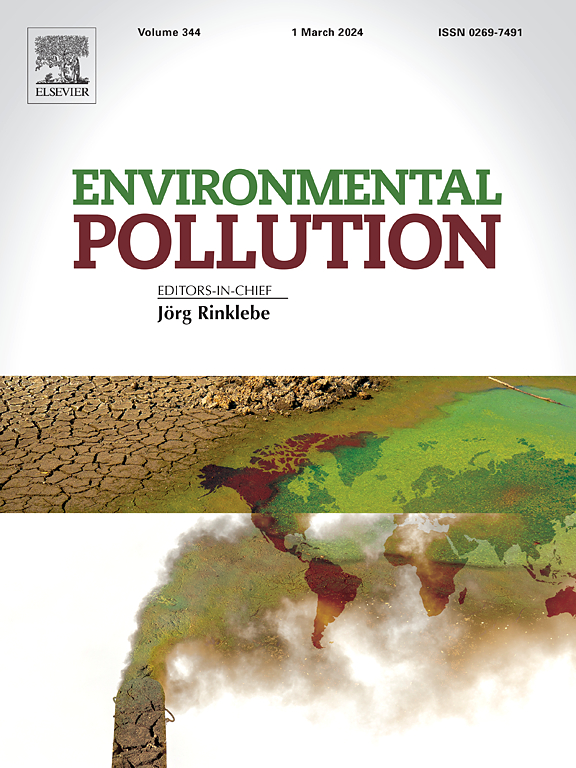升高的温度使吡虫啉对线虫的毒性增大
IF 7.6
2区 环境科学与生态学
Q1 ENVIRONMENTAL SCIENCES
引用次数: 0
摘要
全球变暖使土壤中的生物面临温度升高的压力,同时也改变了这些生物对污染物的解毒过程。温度升高和污染物的双重压力可能会对土壤动物造成协同压力,因此有必要进行详细研究。在此,我们采用全因子实验设计,将吡虫啉(一种新烟碱类杀虫剂)与一系列恒定温度结合起来,让鞘翅目昆虫(Folsomia candida)暴露于其中,以评估其对生存、生长和生物累积的综合影响。结果表明,高温和吡虫啉协同抑制了念珠菌的存活。与未接触吡虫啉的相同温度处理相比,在接触 6.4 毫克/千克吡虫啉的情况下,30.2°C 和 30.5°C 的存活率分别下降了 41.38% 和 68.75%。贝叶斯模型分析证实,吡虫啉和温度对存活率有显著的协同作用。有趣的是,在温度升高时,念珠菌体内吡虫啉的浓度显著降低,而土壤中的杀虫剂浓度保持稳定。这表明,所观察到的协同效应并不是因为温度升高导致污染物在念珠菌体内积累增加,而是因为解毒和热应力管理所需的能量资源耗尽。这种由双重胁迫引起的能量竞争是所观察到的协同作用的基础。我们的研究结果凸显了高温和吡虫啉对鞘翅目昆虫的显著协同效应,强调了在这种条件下生态风险的增加。本文章由计算机程序翻译,如有差异,请以英文原文为准。


Elevated temperature magnifies the toxicity of imidacloprid in the collembolan, Folsomia candida
Global warming subjects soil organisms to elevated temperature stress, while simultaneously altering the detoxification processes for pollutants within these organisms. The combined stressors of increased temperature and pollutants may impose synergistic stress on soil fauna, necessitating detailed investigation. Here, we exposed Collembola (Folsomia candida) to imidacloprid (a neonicotinoid pesticide) in combination with a range of constant temperatures in a full-factorial experimental design to assess the integrated impacts on survival, growth, and bioaccumulation. The results revealed that high temperatures and imidacloprid synergistically inhibited the survival of F. candida. Under 6.4 mg/kg imidacloprid exposure, survival rates decreased by 41.38 % at 30.2 °C and 68.75 % at 30.5 °C, compared to the same temperature treatments without imidacloprid exposure. Bayesian model analysis confirmed a significant synergistic interaction between imidacloprid and temperature on survival. Interestingly, at elevated temperatures, the internal concentration of imidacloprid in F. candida significantly decreased, while the soil concentration of the insecticide remained stable. This suggests that the observed synergistic effect is not due to increased pollutant accumulation within F. candida at higher temperatures, but rather the exhaustion of energy resources needed for detoxification and thermal stress management. This dual-stressor-induced energy competition underpins the synergistic interactions observed. Our findings highlight the significant synergistic effects of high temperatures and imidacloprid on Collembola, underscoring an increased ecological risk under such conditions.
求助全文
通过发布文献求助,成功后即可免费获取论文全文。
去求助
来源期刊

Environmental Pollution
环境科学-环境科学
CiteScore
16.00
自引率
6.70%
发文量
2082
审稿时长
2.9 months
期刊介绍:
Environmental Pollution is an international peer-reviewed journal that publishes high-quality research papers and review articles covering all aspects of environmental pollution and its impacts on ecosystems and human health.
Subject areas include, but are not limited to:
• Sources and occurrences of pollutants that are clearly defined and measured in environmental compartments, food and food-related items, and human bodies;
• Interlinks between contaminant exposure and biological, ecological, and human health effects, including those of climate change;
• Contaminants of emerging concerns (including but not limited to antibiotic resistant microorganisms or genes, microplastics/nanoplastics, electronic wastes, light, and noise) and/or their biological, ecological, or human health effects;
• Laboratory and field studies on the remediation/mitigation of environmental pollution via new techniques and with clear links to biological, ecological, or human health effects;
• Modeling of pollution processes, patterns, or trends that is of clear environmental and/or human health interest;
• New techniques that measure and examine environmental occurrences, transport, behavior, and effects of pollutants within the environment or the laboratory, provided that they can be clearly used to address problems within regional or global environmental compartments.
 求助内容:
求助内容: 应助结果提醒方式:
应助结果提醒方式:


